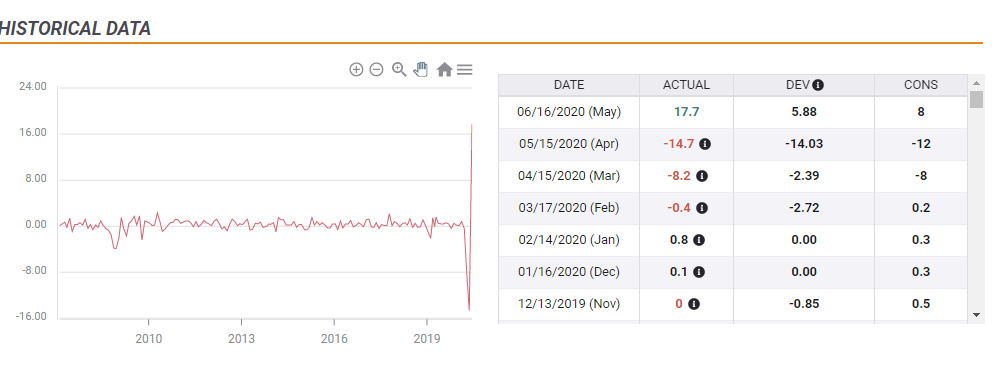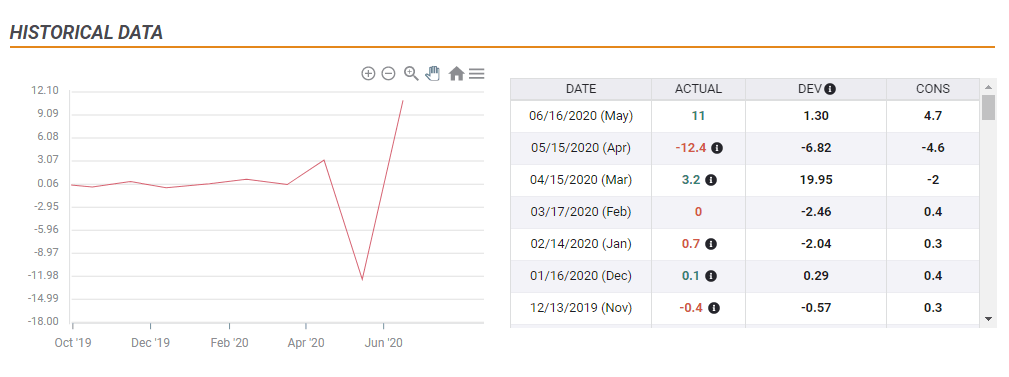- Economists expect US retail sales figures to have risen in June.
- A comeback characterized the beginning of the month and COVID-19 shy consumers later.
- Fiscal stimulus may have boosted consumption more than expected, thus boosting stocks.
Coronavirus hit the consumer hard – but that happened only mid-way through June, thus only partially reflected in the upcoming Retail Sales report. Will the figures show the recovery or the new downturn?
As cases were rising rapidly in Florida, Texas, California, Arizona, and other states, expenditure began dropping in most America. Shoppers and diners did not wait for restrictions – in Texas' cases that included taverns – but skipped social activities.
Economists expect the rebound to continue, perhaps reflecting the first half of the month – and supporting the hopes of a V-shaped recovery. Headline sales tumbled by 8.2% in March and 14.7% in April, before rebounding by 17.7% in May. For June, estimates stand at an increase of 5%, sending the total volume closer to the levels that were seen in February.
The Retail Sales Control Group – also known as the "core of the core" – has suffered less than the headline, surprisingly rising in March by 3.2%, then tumbling by 12.4% in April and bouncing by 11% in May.
The measure is projected to rise by 3.6% in June. That would put the control group back to pre-pandemic levels.
Are these projections too optimistic? Probably not.
Three reasons to be optimistic
1) Mid-June
Coronavirus cases were under control up to the middle of last month and state accelerated their reopening – encouraging shoppers to buy. The change was not sudden but gradual, and the figures will likely better reflect the increase in expenditure rather than the renewed downturn.
Moreover, it is essential to note that retail sales figures experience substantial revisions – and the slide in the latter part of the month may be reflected only with the modified data, not the initial release.
2) Cases rose in the south, retreated in the north
In mid-July when the data is due, COVID-19 infections are rising in most of America, the mortality rate is on the rise, and hospitals in some cities are filling. However, while several states in the south were experiencing a surge during June, the greater New York area continued seeing an improvement.
Life returned to normal in some places while some were hunkering down, balancing the picture.
3) Fiscal stimulus
Congress approved multi-trillion relief packages, including a $600 per week top-tup for the unemployed and a $1,200 check for every American. Additional funds were sent to large and small firms.
The money could not be spent at once – especially not during the severe lockdowns. Some of the expenditure was deferred from April to May, but more probably occurred in June.
Consumers may have wanted to compensate themselves for the lost time – not only by splashing on home-improvement equipment, but also on eating out, buying clothes, and other activities. While some of the government programs' effect was already seen, it may have likely spilled into June.
Market reaction
Investors are bullish – currently not on the US consumer – but on hopes for a coronavirus vaccine. Reports of progress by both Moderna and AstraZeneca have kept equities bid. It would take horrible retail sales figures to depress investors.
If sales meet expectations, marginally miss them, or surprise with a beat, the S&P 500 will likely rise and the safe-haven dollar could fall.
Only negative retail sales statistics would send stocks down the greenback higher – and that seems highly unlikely.
Weekly US jobless claims are released at the same time, 12:30 GMT. However, initial claims are for the week ending July 10 and continuing claims are for that concluding July 3 – both not consisting of July 12, when the Non-Farm Payrolls surveys are held.
Moreover, consumption is central to the US economy, and the monthly retail sales report will likely overshadow weekly labor statistics.
Conclusion
Overall, the recovery likely extended through June as most of the nation was still reopening during around half of the month and as government support helps. The upbeat market mood implies only a devastating report would dampen the mood, while anything else would be market-positive.
Information on these pages contains forward-looking statements that involve risks and uncertainties. Markets and instruments profiled on this page are for informational purposes only and should not in any way come across as a recommendation to buy or sell in these assets. You should do your own thorough research before making any investment decisions. FXStreet does not in any way guarantee that this information is free from mistakes, errors, or material misstatements. It also does not guarantee that this information is of a timely nature. Investing in Open Markets involves a great deal of risk, including the loss of all or a portion of your investment, as well as emotional distress. All risks, losses and costs associated with investing, including total loss of principal, are your responsibility. The views and opinions expressed in this article are those of the authors and do not necessarily reflect the official policy or position of FXStreet nor its advertisers. The author will not be held responsible for information that is found at the end of links posted on this page.
If not otherwise explicitly mentioned in the body of the article, at the time of writing, the author has no position in any stock mentioned in this article and no business relationship with any company mentioned. The author has not received compensation for writing this article, other than from FXStreet.
FXStreet and the author do not provide personalized recommendations. The author makes no representations as to the accuracy, completeness, or suitability of this information. FXStreet and the author will not be liable for any errors, omissions or any losses, injuries or damages arising from this information and its display or use. Errors and omissions excepted.
The author and FXStreet are not registered investment advisors and nothing in this article is intended to be investment advice.
Recommended Content
Editors’ Picks
AUD/USD remained bid above 0.6500

AUD/USD extended further its bullish performance, advancing for the fourth session in a row on Thursday, although a sustainable breakout of the key 200-day SMA at 0.6526 still remain elusive.
EUR/USD faces a minor resistance near at 1.0750

EUR/USD quickly left behind Wednesday’s small downtick and resumed its uptrend north of 1.0700 the figure, always on the back of the persistent sell-off in the US Dollar ahead of key PCE data on Friday.
Gold holds around $2,330 after dismal US data

Gold fell below $2,320 in the early American session as US yields shot higher after the data showed a significant increase in the US GDP price deflator in Q1. With safe-haven flows dominating the markets, however, XAU/USD reversed its direction and rose above $2,340.
Bitcoin price continues to get rejected from $65K resistance as SEC delays decision on spot BTC ETF options

Bitcoin (BTC) price has markets in disarray, provoking a broader market crash as it slumped to the $62,000 range on Thursday. Meanwhile, reverberations from spot BTC exchange-traded funds (ETFs) continue to influence the market.
US economy: slower growth with stronger inflation

The dollar strengthened, and stocks fell after statistical data from the US. The focus was on the preliminary estimate of GDP for the first quarter. Annualised quarterly growth came in at just 1.6%, down from the 2.5% and 3.4% previously forecast.

